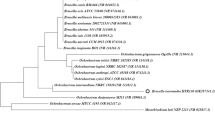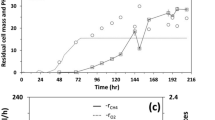Summary
Poly-β-hydroxybutyric acid (PHB) and similar bacterial polyesters are promising candidates for the development of environment-friendly, totally biodegradable plastics. The use of methanol, one of the cheapest noble substrates available, may help to reduce the cost of producing such bioplastics. As a first step, a culture collection of 118 putative methylotrophic microorganisms was obtained from various soil samples without any laboratory enrichment step to favour culture diversity. The most promising culture was selected based on rapidity of growth and PHB accumulation and later identified as Methylobacterium extorquens. This isolate was obtained from soml contaminated regularly with used oil products for some 40 years. Concentrations of methanol greater than 8 g/l affected growth significantly and the methanol concentration was optimal at 1.7 g/l. PHB concentrations averaged 25–30% (w/v) of dry weight under non-optimized conditions. Controlling methanol concentration, using an open-loop configuration, led to biomass levels of 9–10 g/l containing 30–33% PHB while preventing methanol accumulation. The new isolate was also able to produce the co-polymer PHB/poly-β-hydroxyvalerate (PHV) using the mixture methanol + valerate. The PHV-to-PHB ratio was about 0.2 at the end of the fermentation. An average molecular mass varying between 2 and 3 × 105 Da was obtained for three PHB samples using two different measurement methods.
Similar content being viewed by others
References
Akita S, Einaga Y, Miyaki Y, Fugita H (1976) Solution properties of poly(d-β-hydroxybutyrate). 1. Biosynthesis and characterization. Macromolecules 9:774–780
American Type Culture Collection (1985) Gherna R, Nierman W, Pienta P (eds) Catalogue of bacteria, phages and rDNA vectors, 16th edn. ATCC, Rockville, Md.
Anthony C (1982) The biochemistry of methylotrophs, chapter 1. Academic Press, New York
Asenjo JA, Suk JS (1986) Microbial conversion of methane into poly-β-hydroxybutyrate (PHB): growth and intracellular product accumulation in a type II methanotroph. J Ferment Technol 64:271–278
Berger E, Ramsay BA, Ramsay JA, Chavarie C (1989) PHB recovery by hypochlorite digestion of non-PHB biomass. Biotechnol Technol 3:227–232
Bousfield IJ, Green PN (1985) Reclassification of bacteria of the genus Protomonas Urakami and Komagata 1984 in the genus Methylobacterium (Patt, Cole, and Hanson) Emend. Green and Bousfield 1983. Int J Syst Bacteriol 35:209
Braunegg G, Sonnleitner B, Lafferty RM (1978) A rapid gas chromatographic method for the determination of poly-β-hydroxybutyric acid in microbial biomass. Eur J Appl Microbiol Biotechnol 6:29–37
Byrom D (1987) Polymer synthesis by microorganisms: technology and economics. Tibtech 5:246–250
Collins SH (1987) Choice of substrate in polyhydroxybutyrate synthesis. In: Stowell JD, Beardsmore AJ, Keevil CW, Woodward JR (eds) Carbon substrates in biotechnology (Special Publications of the Society for General Microbiology). IRL Press, Oxford, pp 161–168
Dawes EA (1988) Polyhydroxybutyrate: an intriguing biopolymer. Biosci Rep 8:537–547
Dijkhuizen L, Hansen TA, Harder W (1985) Methanol, a potential feedstock for biotechnological process. Tibtech 3:262–267
Green PN, Bousfield IJ (1983) Emendation of Methylobacterium Patt, Cole, and Hanson 1976; Methylobacterium rhodinum (Heumann 1962) comb. nov. corrig.; Methylobacterium radiotolerans (Ito and Iizuka 1971) comb. nov. corrig.; and Methylobacterium mesophilicum (Austin and Goodfellow 1979) comb. nov. Int J Syst Bacteriol 33:875–877
Haywood GW, Anderson AJ, Dawes EA (1989) A survey of the accumulation of novel polyhydroxyalkanoates by bacteria. Biotechnol Lett 11:471–476
Hilger U, Sattler K, Littkowsky U (1991) Studies on the growth-associated accumulation of poly-β-hydroxybutyric acid with Methylobacterium rhodesianum Z. Zentralbl Mikrobiol 146:83–88
Lafferty RM, Korsatko B, Korsatko W (1988) Microbial production of poly-β-hydroxybutyric acid. In: Rehm HJ, Reed G (eds) Biotechnology, vol 6B. VCH, Weinheim
Large PJ, Bamforth CW (1988) Methylotrophy and biotechnology. Longman Scientific & Technical, Burnt Mill, Harlow, UK
Large PJ, Quayle JR (1963) Microbial growth on C1 compounds. 5. Enzyme activities in extracts of Pseudomonas AM1. Biochem J 87:386–396
Luong JHT (1987) Generalization of Monod kinetics for analysis of growth data with substrate inhibition. Biotechnol Bioeng 29:242–248
Marchessault RH, Okamura K, Su CJ (1970) Physical properties of poly (β-hydroxybutyrate). II. Conformational aspects in solution. Macromolecules 3:735–740
Powell KA, Collinson BA, Richardson KR (1980) Microbiological process for the production of poly (beta-hydroxybutyric acid) and micro-organisms for use therein. European patent application no. 80300432.4
Suzuki T, Yamane T, Shimizu S (1986a) Mass production of poly-β-hydroxybutyric acid by fully automatic fed-batch culture of methylotroph. Appl Microbiol Biotechnol 23:322–329
Suzuki T, Yamane T, Shimizu S (1986b) Kinetics and effect of nitrogen source feeding on production of poly-β-hydroxybutyric acid by fed-batch culture. Appl Microbiol Biotechnol 24:366–369
Suzuki T, Yamane T, Shimizu S (1986c) Mass production of poly-β-hydroxybutyric acid by fed-batch culture with controlled carbon/nitrogen feeding. Appl Microbiol Biotechnol 24:370–374
Suzuki T, Deguchi H, Yamane T, Shimizu S, Gekko K (1988) Control of molecular weight of poly-β-hydroxybutyric acid produced in fed-batch culture of Protomonas extorquens. Appl Microbiol Biotechnol 27:487–491
Tani Y (1984) Microbiology and biochemistry of methylotrophic yeasts. In: Hou CT (ed) Methylotrophs: microbiology, biochemistry, and genetics, CRC Press, Boca Raton, Fla.
Toennies G, Gallant D (1949) The relation between photometric turbidity and bacterial concentration (bacterimetric studies IV). Growth 13:7–20
Weaver TL, Patrick MA, Dugan PR (1975) Whole-cell and membrane lipids of the methylotrophic bacterium Methylosinus trichosporium. J Bacteriol 124:602–606
Author information
Authors and Affiliations
Additional information
Publication number NRCC No. 33672
Offprint requests to: D. Groleau
Rights and permissions
About this article
Cite this article
Bourque, D., Ouellette, B., André, G. et al. Production of poly-β-hydroxybutyrate from methanol: characterization of a new isolate of Methylobacterium extorquens . Appl Microbiol Biotechnol 37, 7–12 (1992). https://doi.org/10.1007/BF00174194
Received:
Accepted:
Issue Date:
DOI: https://doi.org/10.1007/BF00174194




